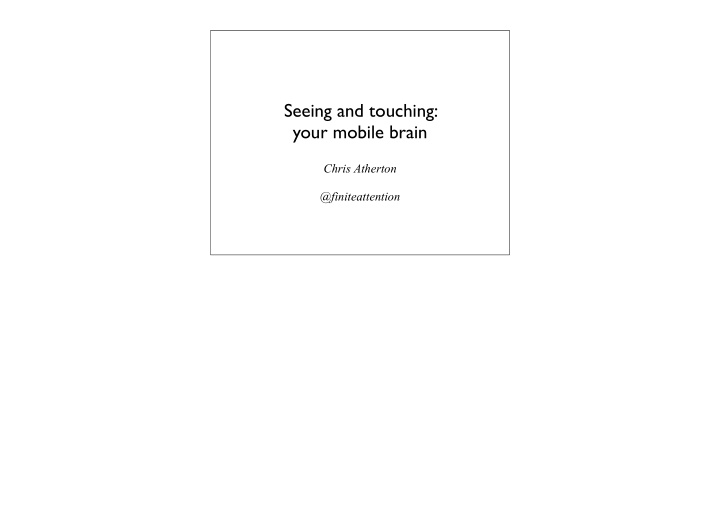



Seeing and touching: your mobile brain Chris Atherton @finiteattention
1. How our brains see
2. How we synthesise reality
3. How we fail at seeing
4. Computers and stupidity
5. Married to the Mob(ile)
1. How our brains see
… different neurones already processing the information from each eye …
… different neurones encode what you’re looking at, vs. where it is …
…different neurones encode hue and contrast …
www.owlnet.rice.edu
V1 line fragments www.owlnet.rice.edu
V2 what and where www.owlnet.rice.edu
V2 illusory contours www.owlnet.rice.edu
V3 motion www.owlnet.rice.edu
V5 motion and direction www.owlnet.rice.edu
V4 colour www.owlnet.rice.edu
Where fast pathway www.owlnet.rice.edu
What slow pathway www.owlnet.rice.edu
Quinlan & Wilton, 1999
Quinlan & Wilton, 1999
Quinlan & Wilton, 1999
Quinlan & Wilton, 1999
2. How we synthesise reality
time taken to recognise object orientation Jolicoeur, 1985
hesslow.com
time taken to solve puzzle angular disparity Shepard & Metzler, 1971
our brains seem to really like reality
globalmoxie.com
nostalgic-images.co.uk
angrybirds.com
mental models
globalmoxie.com
“The procedure is quite simple. First, you arrange items into different groups. Of course, one pile may be sufficient, depending on how much there is to do. If you have to go somewhere else due to lack of facilities, that is the next step; otherwise, you are pretty well set. It is important not to overdo things. That is, it is better to do too few things at once than too many. In the short run, this may not seem important, but complications can easily arise.”
“The procedure is quite simple. First, you arrange items into different groups. Of course, one pile may be sufficient, depending on how much there is to do. If you have to go somewhere else due to lack of facilities, that is the next step; otherwise, you are pretty well set. It is important not to overdo things. That is, it is better to do too few things at once than too many. In the short run, this may not seem important, but complications can easily arise.” Bransford & Johnson, 1972
3. How we fail at seeing
max. working memory load: 4-5 things
“change blindness”
Flash prototype interlude
4. Computers and stupidity
attention 4. Computers and stupidity
us attention 4. Computers and stupidity
4. Cyborgs us attention 4. Computers and stupidity
“magic number 7” +/- 2 Miller, 1956
“magical number 4” Cowan, 2001
max. working memory load: 4-5 things
important note
subitization
max. working memory load: 4-5 things
Frühstuck Kaffee Call Dad Get train to airport
Infinite working memory — <
max. working memory load: 4-5 things
max. working memory load: all you can eat
Site that should know better Title that belongs in a tabloid newspaper Story about usability or UX or some aspect of software-related human experience that turns out OBLIGATORY to have no supporting evidence BUT WHOLLY UNRELATED in it from brain studies of any BRAIN PIC kind, though it may mention the brain several times.
Site that should know better Title that belongs in a tabloid newspaper story more likely to be rated as exhibiting good Story about usability or UX or some aspect of software-related scientific reasoning human experience that turns out OBLIGATORY to have no supporting evidence BUT WHOLLY UNRELATED in it from brain studies of any BRAIN PIC kind, though it may mention the brain several times. McCabe & Castel, 2008
“the seductive allure of neuroscience explanations” Skolnick Weisberg et al., 2008
http://flickr.com/photos/quinn/4252155172
“the seductive allure of ‘seductive allure’” Farah & Hooke, 2013
Nicholas Carr: roughtype.com
Nicholas Carr: ! roughtype.com
5. Married to the Mob(ile)
‘embodied cognition’
Williams & Bargh, 2008
Recommend
More recommend